Paper Menu >>
Journal Menu >>
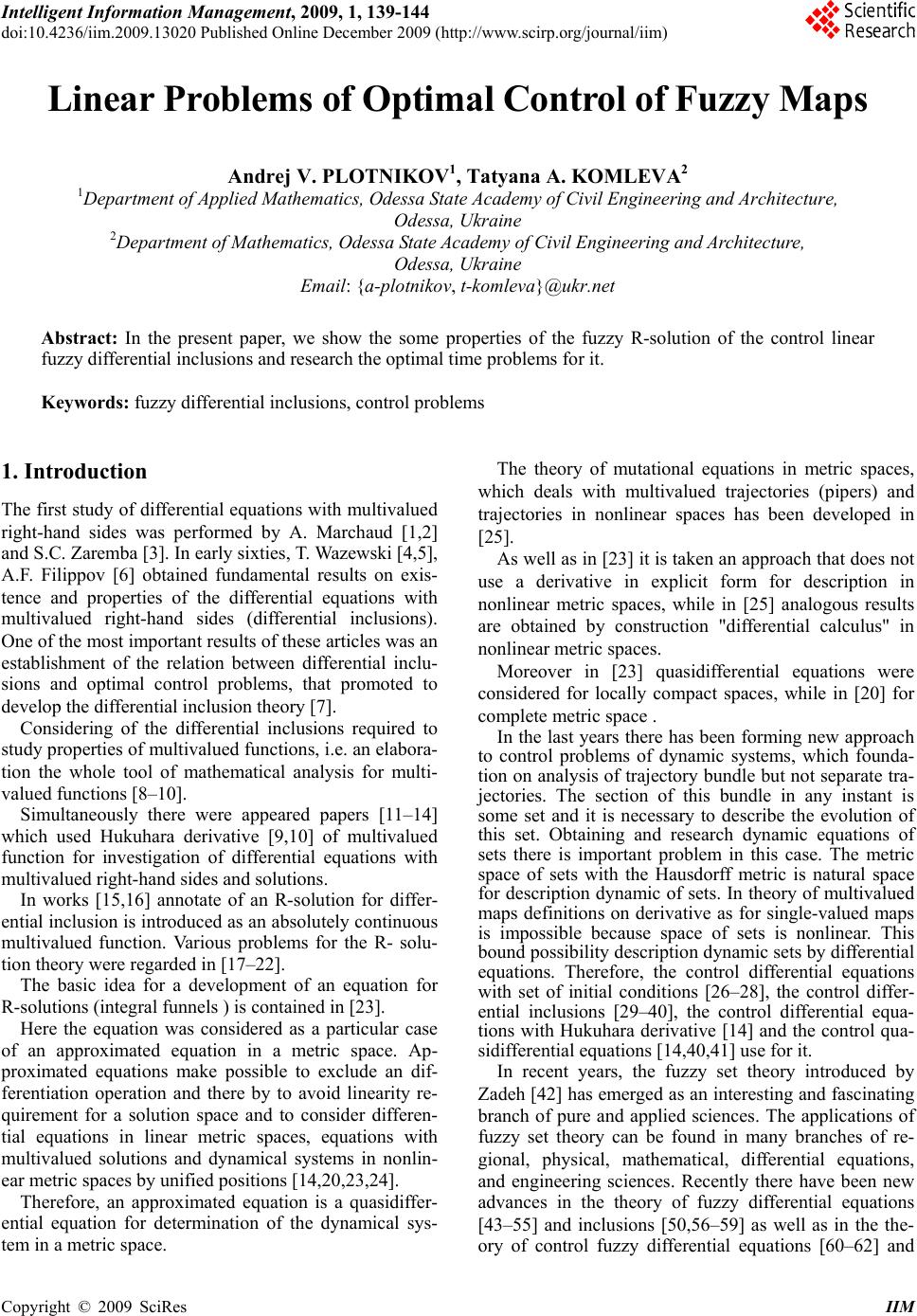 Intelligent Information Management, 2009, 1, 139-144 doi:10.4236/iim.2009.13020 Published Online December 2009 (http://www.scirp.org/journal/iim) Copyright © 2009 SciRes IIM Linear Problems of Optimal Control of Fuzzy Maps Andrej V. PLOTNIKOV1, Tatyana A. KOMLEVA2 1Department of Applied Mathematics, Odessa State Academy of Civil Engineering and Architecture, Odessa, Ukraine 2Department of Mathematics, Odessa State Academy of Civil Engineering and Architecture, Odessa, Ukraine Email: {a-plotnikov, t-komleva}@ukr.net Abstract: In the present paper, we show the some properties of the fuzzy R-solution of the control linear fuzzy differential inclusions and research the optimal time problems for it. Keywords: fuzzy differential inclusions, control problems 1. Introduction The first study of differential equations with multivalued right-hand sides was performed by A. Marchaud [1,2] and S.C. Zaremba [3]. In early sixties, T. Wazewski [4,5], A.F. Filippov [6] obtained fundamental results on exis- tence and properties of the differential equations with multivalued right-hand sides (differential inclusions). One of the most important results of these articles was an establishment of the relation between differential inclu- sions and optimal control problems, that promoted to develop the differential inclusion theory [7]. Considering of the differential inclusions required to study properties of multivalued functions, i.e. an elabora- tion the whole tool of mathematical analysis for multi- valued functions [8–10]. Simultaneously there were appeared papers [11–14] which used Hukuhara derivative [9,10] of multivalued function for investigation of differential equations with multivalued right-hand sides and solutions. In works [15,16] annotate of an R-solution for differ- ential inclusion is introduced as an absolutely continuous multivalued function. Various problems for the R- solu- tion theory were regarded in [17–22]. The basic idea for a development of an equation for R-solutions (integral funnels ) is contained in [23]. Here the equation was considered as a particular case of an approximated equation in a metric space. Ap- proximated equations make possible to exclude an dif- ferentiation operation and there by to avoid linearity re- quirement for a solution space and to consider differen- tial equations in linear metric spaces, equations with multivalued solutions and dynamical systems in nonlin- ear metric spaces by unified positions [14,20,23,24]. Therefore, an approximated equation is a quasidiffer- ential equation for determination of the dynamical sys- tem in a metric space. The theory of mutational equations in metric spaces, which deals with multivalued trajectories (pipers) and trajectories in nonlinear spaces has been developed in [25]. As well as in [23] it is taken an approach that does not use a derivative in explicit form for description in nonlinear metric spaces, while in [25] analogous results are obtained by construction "differential calculus" in nonlinear metric spaces. Moreover in [23] quasidifferential equations were considered for locally compact spaces, while in [20] for complete metric space . In the last years there has been forming new approach to control problems of dynamic systems, which founda- tion on analysis of trajectory bundle but not separate tra- jectories. The section of this bundle in any instant is some set and it is necessary to describe the evolution of this set. Obtaining and research dynamic equations of sets there is important problem in this case. The metric space of sets with the Hausdorff metric is natural space for description dynamic of sets. In theory of multivalued maps definitions on derivative as for single-valued maps is impossible because space of sets is nonlinear. This bound possibility description dynamic sets by differential equations. Therefore, the control differential equations with set of initial conditions [26–28], the control differ- ential inclusions [29–40], the control differential equa- tions with Hukuhara derivative [14] and the control qua- sidifferential equations [14,40,41] use for it. In recent years, the fuzzy set theory introduced by Zadeh [42] has emerged as an interesting and fascinating branch of pure and applied sciences. The applications of fuzzy set theory can be found in many branches of re- gional, physical, mathematical, differential equations, and engineering sciences. Recently there have been new advances in the theory of fuzzy differential equations [43–55] and inclusions [50,56–59] as well as in the the- ory of control fuzzy differential equations [60–62] and 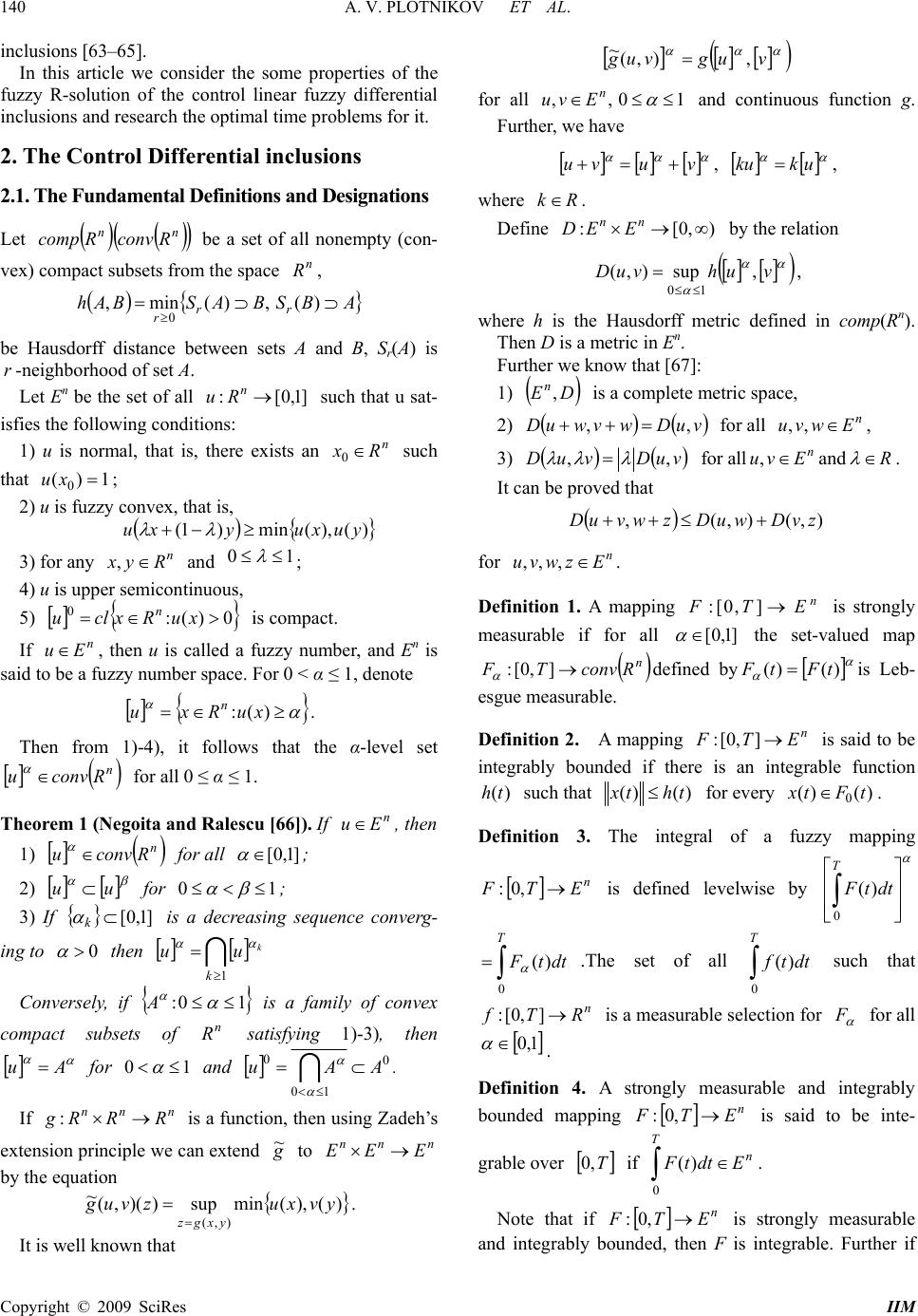 A. V. PLOTNIKOV ET AL. 140 inclusions [63–65]. In this article we consider the some properties of the fuzzy R-solution of the control linear fuzzy differential inclusions and research the optimal time problems for it. 2. The Control Differential inclusions 2.1. The Fundamental Definitions and Designations Let nn RconvRcomp be a set of all nonempty (con- vex) compact subsets from the space , n R ABSBASBAh rr r )(,)(min, 0 be Hausdorff distance between sets A and B, Sr(A) is r -neighborhood of set A. Let En be the set of all such that u sat- isfies the following conditions: ]1,0[: n Ru 1) u is normal, that is, there exists an such that ; n Rx 0 1)(0xu 2) u is fuzzy convex, that is, )(),(min)1( yuxuyxu 3) for any and n Ryx ,10 ; 4) u is upper semicontinuous, 5) is compact. 0)(: 0 xuRxclu n If , then u is called a fuzzy number, and En is said to be a fuzzy number space. For 0 < α ≤ 1, denote n Eu )(: xuRxu n. Then from 1)-4), it follows that the α-level set for all 0 ≤ α ≤ 1. n Rconvu Theorem 1 (Negoita and Ralescu [66]). If , then n Eu 1) for all n Rconvu ]1,0[ ; 2) for uu 10 ; 3) If ]1,0[ k is a decreasing sequence converg- ing to 0 then 1 k k uu Conversely, if 10: A n R 1 is a family of convex compact subsets of satisfying 1)-3), then for Au 0 and 0 10 0AAu . If is a function, then using Zadeh’s extension principle we can extend nnn RRRg: g ~ to by the equation nnn EEE )(),(minsup))(,( ~ ),( yvxuzvug yxgz . It is well known that vugvug ,),( ~ for all and continuous function g. Further, we have 10,, n Evu vuvu, , ukku where Rk . Define by the relation ),0[: nn EED vuhvuD ,sup),( 10 , where h is the Hausdorff metric defined in comp(Rn). Then D is a metric in En. Further we know that [67]: 1) DEn, is a complete metric space, 2) vuDwvwuD ,, for all , n Ewvu ,, 3) vuDvuD ,, for alland n Evu ,R . It can be proved that ),(),(, zvDwuDzwvuD for . n Ezwvu ,,, Definition 1. A mapping is strongly measurable if for all n ETF ],0[: ]1,0[ the set-valued map n RconvTF ],0[: defined byis Leb- esgue measurable. ()( FtF )t Definition 2. A mapping is said to be integrably bounded if there is an integrable function such that n ETF ],0[: )(th) )(tx()( thtx for every . )( 0tF Definition 3. The integral of a fuzzy mapping n ETF,0: is defined levelwise by .The set of all such that is a measurable selection for for all T dttF 0 )( F T dttF 0 )( n RTf ],0[: T dttf 0 )( 1,0 . Definition 4. A strongly measurable and integrably bounded mapping n ETF,0: is said to be inte- grable over T,0 if . T n EdttF 0 )( Note that if n ET ,0:F is strongly measurable and integrably bounded, then F is integrable. Further if Copyright © 2009 SciRes IIM 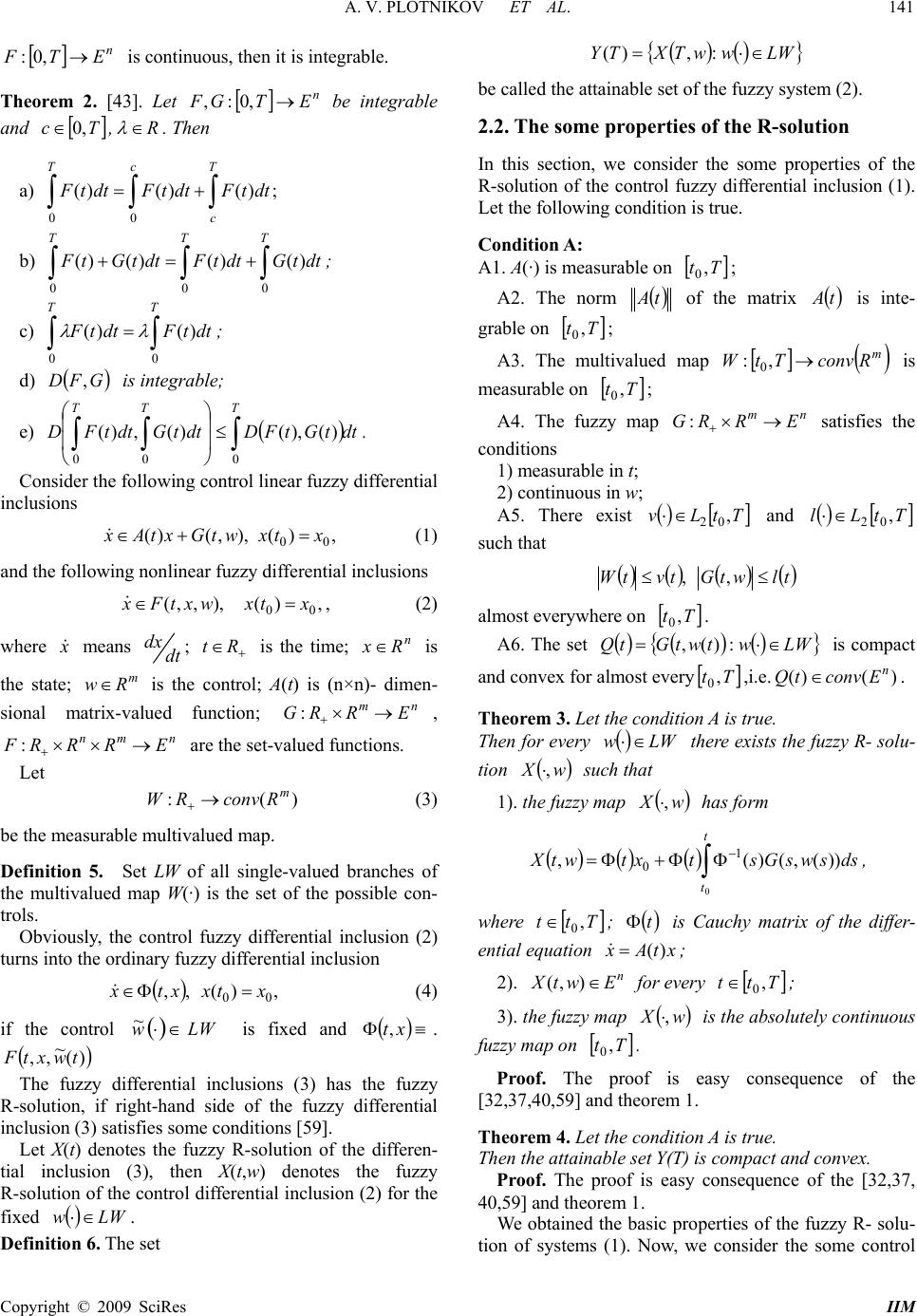 A. V. PLOTNIKOV ET AL. 141 n ETF ,0: is continuous, then it is integrable. Theorem 2. [43]. Let n ETGF ,0:, be integrable and , Tc ,0R . Then a) TT c c dttFdttF 00 ;)()(dttF )( T GtF 0 )( T dttF 0 )( GFD , tFD )( x x b) ; TT dttGdttFdtt 00 )()()( c) ; T dttF 0 )( d) is integrable; e) . dttGtFDdttGdt TTT 000 )(),()(, Consider the following control linear fuzzy differential inclusions ,)(),,()( 00 xtxwtGxtA (1) and the following nonlinear fuzzy differential inclusions ,)(),,,( 00 xtxwxtFx , (2) where means dt dx ; is the time; is the state; is the control; A(t) is (n×n)- dimen- sional matrix-valued function; , are the set-valued functions. Rtn Rx nmE m Rw mn RRRF : x RRG : n E Let )(: m RconvRW (3) be the measurable multivalued map. Definition 5. Set LW of all single-valued branches of the multivalued map W(·) is the set of the possible con- trols. Obviously, the control fuzzy differential inclusion (2) turns into the ordinary fuzzy differential inclusion ,)(,, 00 xtxxt (4) if the control LWw ~ is fixed and xt,. )( ~ ,, twxtF LWw The fuzzy differential inclusions (3) has the fuzzy R-solution, if right-hand side of the fuzzy differential inclusion (3) satisfies some conditions [59]. Let X(t) denotes the fuzzy R-solution of the differen- tial inclusion (3), then X(t,w) denotes the fuzzy R-solution of the control differential inclusion (2) for the fixed . Definition 6. The set LWwwTXTY :,)( be called the attainable set of the fuzzy system (2). 2.2. The some properties of the R-solution In this section, we consider the some properties of the R-solution of the control fuzzy differential inclusion (1). Let the following condition is true. Condition A: A1. A(·) is measurable on Tt , 0; A2. The norm tA of the matrix is inte- grable on tA Tt , 0; A3. The multivalued map m RconvTtW,: 0 is measurable on Tt , 0; A4. The fuzzy map satisfies the conditions nmERRG : 1) measurable in t; 2) continuous in w; A5. There exist TtLv , 02 and TtLl , 02 such that tlwtGtvtW ,, almost everywhere on Tt , 0. A6. The set LWwtwtGtQ :)(, Tt , 0)(tQ is compact and convex for almost every ,i.e. . )( n Econv Theorem 3. Let the condition A is true. Then for every LWw there exists the fuzzy R- solu- tion wX, such that 1). the fuzzy map wX, has form t t dsswsGstxtwtX 0 ))(,()(, 1 0, where Ttt , 0 ; t is Cauchy matrix of the differ- ential equation xtA )(x ; 2). for every ; n EwtX ),( Ttt , 0 3). the fuzzy map wX, is the absolutely continuous fuzzy map on Tt , 0. Proof. The proof is easy consequence of the [32,37,40,59] and theorem 1. Theorem 4. Let the condition A is true. Then the attainable set Y(T) is compact and convex. Proof. The proof is easy consequence of the [32,37, 40,59] and theorem 1. We obtained the basic properties of the fuzzy R- solu- tion of systems (1). Now, we consider the some control Copyright © 2009 SciRes IIM 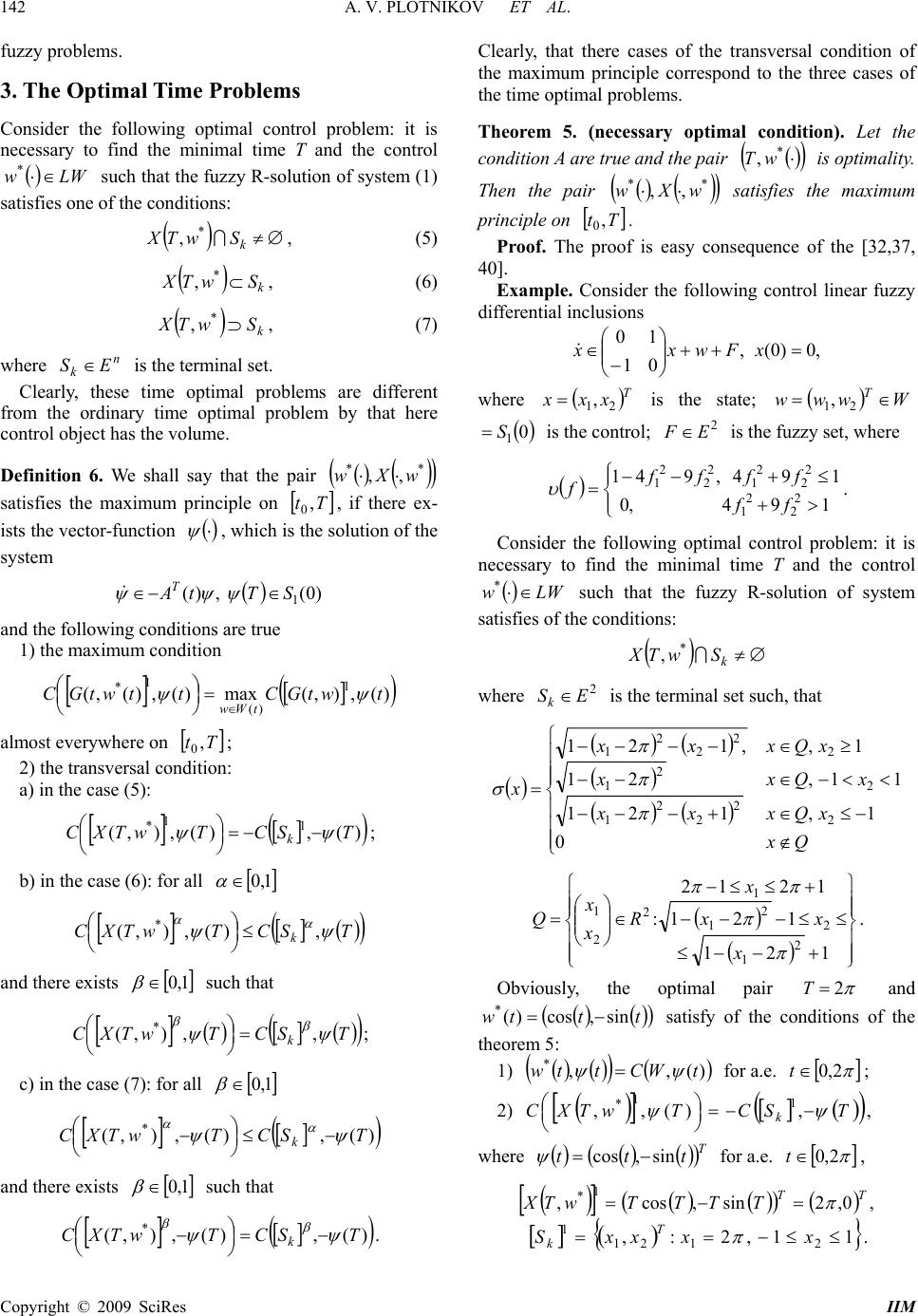 A. V. PLOTNIKOV ET AL. 142 Clearly, that there cases of the transversal condition of the maximum principle correspond to the three ses of pair ca fuzzy problems. 3. The Optimal Time Problems Consider the following optimal control problem: it is necessary to find the minimal time T and the control such that the fuzzy R-solution of system (1) satisfies one of the conditions: LWw * k SwTX * ,, (5) k SwTX * ,, (6) k SwTX * ,, (7) where is the terminal set. n kES Clearly, these time optimal problems are different from the ordinary time optimal problem by that here control object has the volume. Definition 6. We shall say that the pair ** ,, wXw T satisfies the maximum principle on , if there ex- ists the vector-functio t, 0 n , which is the solution of the system )0(,)( 1 STtAT and the following conditions are true 1) the maximum condition )(,),(max)(,)(,(1 )( 1 *twtGCttwtGС tWw almost everywhere on ; Tt , 0 2) the transversal condition: a) in the case (5): )(,)(,),( 1 1 *TSCTwTXC k ; b) in the case (6): for all 1,0 TSCTwTXC k ,)(,),(* and there exists 1,0 such that TSCTwTXC k ,,),( * ; c) in the case (7): for all 1,0 )(,)(,),( *TSCTwTXC k and there exists 1,0 such that )(,)(,),( *TSCTwTXC k . the time optimal problems. Theorem 5. (necessary optimal condition). Let the condition A are true and the * ,wT is optimality. Then the pair ** ,,wXw satisfies the maximum principle on Tt ,. 0 Proof. The proonsequence of the [32,37, 40]. f is easy co where Example. Consider the following control linear fuzzy differential inclusions ,0)0(, 01 10 xFwxx T xxx21, is the state; Wwww T 2 , 1 0S1 is the control; 2 E F is the fuzzy set, where 194,41 2 2 194,0 9 2 2 1 2 2 2 ff f2 Consider the following optimal control prob: it is necessary to find the minimal time T and the control 2 11 fff f . lem LW * such that the fuzzy R-solution of system satisfies of the conditions: w SwTX * , k where is the terminal set su, that 2 ESk ch xQxxx ,,122 2 2 2 1 Qx xQxxx xQxx x 0 1,121 11,21 11 2 2 2 2 1 2 2 1 121 121 1212 : 2 1 2 2 1 1 2 2 1 x xx x R x x Q. 2T Obviously, the optimal pair and tttw sin,cos)( * satisfy of the co of the th 1) nditions eorem 5: )(, t for a.e. , *WCttw 2,0t; 2) TTwTXC ,)(,, 1 1 *SC k , for a.e. 2,0t, where T ttt sin,cos ,0,2,cos, 1 *TTwT sin TT TTX 11,2:, 2121 1 xxxxS T k . Copyright © 2009 SciRes IIM 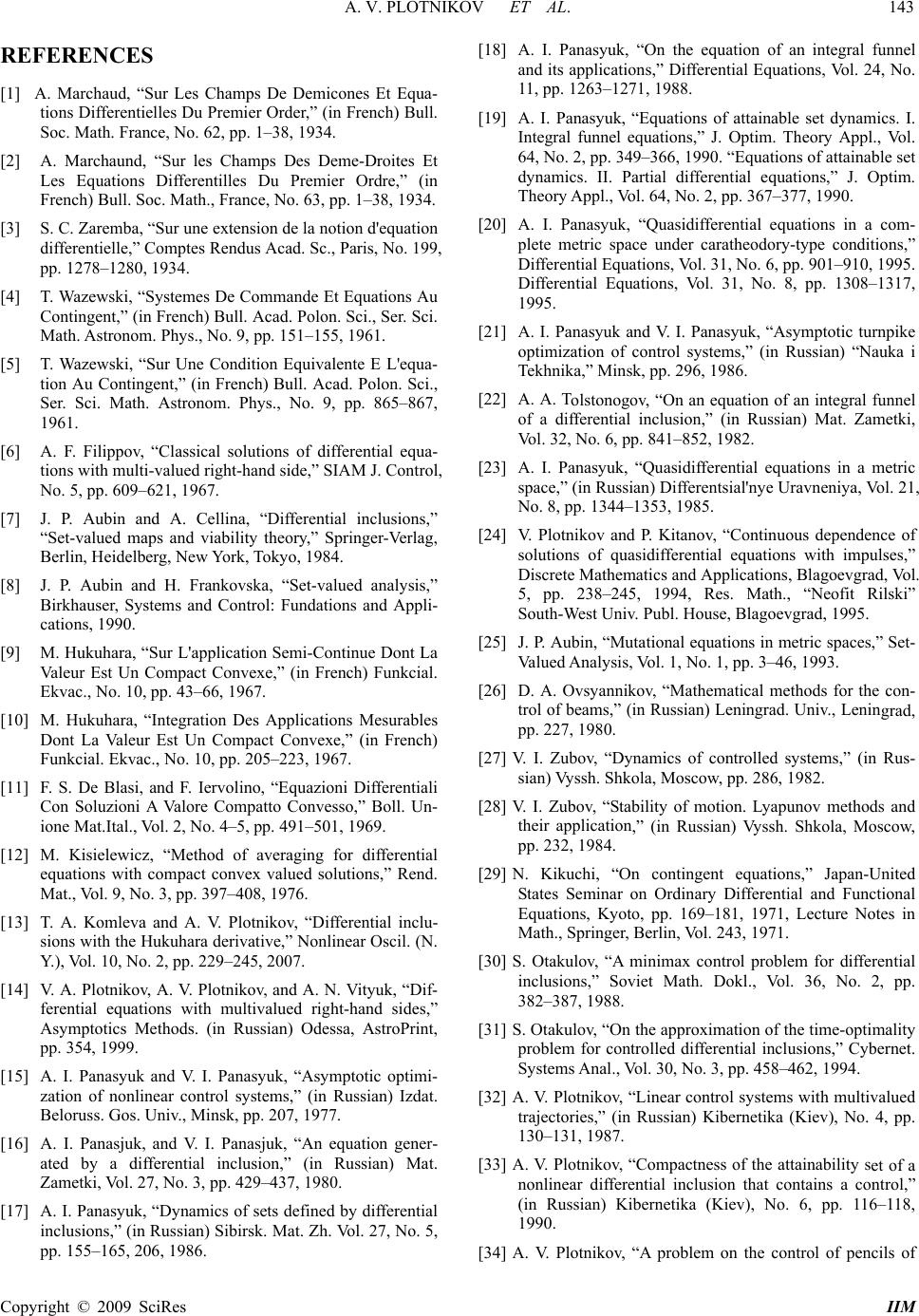 A. V. PLOTNIKOV ET AL. 143 REFERENCES [1] A. Marchaud, “Sur Les Champs De Demicones Et Equ es Du Premier Order,” (in French) Bull. , No. 62, pp. 1–38, 1934. egral funnel ns of attainable set dynamics. I. , pp. 367–377, 1990. olstonogov, “On an equation of an integral funnel equations in a metric uous dependence of , Blagoevgrad, 1995. grad, (in Rus- ,” (in Russian) Vyssh. Shkola, Moscow, pan-United e time-optimality Linear control systems with multivalued et of a [34] A. V. Plotnikov, “A problem on the control of pencils of a- an tions Differentiell Soc. Math. France [2] A. Marchaund, “Sur les Champs Des Deme-Droites Et Les Equations Differentilles Du Premier Ordre,” (in French) Bull. Soc. Math., France, No. 63, pp. 1–38, 1934. [3] S. C. Zaremba, “Sur une extension de la notion d'equation differentielle,” Comptes Rendus Acad. Sc., Paris, No. 199, pp. 1278–1280, 1934. [4] T. Wazewski, “Systemes De Commande Et Equations Au Contingent,” (in French) Bull. Acad. Polon. Sci., Ser. Sci. Math. Astronom. Phys., No. 9, pp. 151–155, 1961. [5] T. Wazewski, “Sur Une Condition Equivalente E L'equa- tion Au Contingent,” (in French) Bull. Acad. Polon. Sci., Ser. Sci. Math. Astronom. Phys., No. 9, pp. 865–867, 1961. [6] A. F. Filippov, “Classical solutions of differential equa- tions with multi-valued right-hand side,” SIAM J. Control, No. 5, pp. 609–621, 1967. [7] J. P. Aubin and A. Cellina, “Differential inclusions,” “Set-valued maps and viability theory,” Springer-Verlag, Berlin, Heidelberg, New York, Tokyo, 1984. [8] J. P. Aubin and H. Frankovska, “Set-valued analysis,” Birkhauser, Systems and Control: Fundations and Appli- cations, 1990. [9] M. Hukuhara, “Sur L'application Semi-Continue Dont La Valeur Est Un Compact Convexe,” (in French) Funkcial. Ekvac., No. 10, pp. 43–66, 1967. [10] M. Hukuhara, “Integration Des Applications Mesurables Dont La Valeur Est Un Compact Convexe,” (in French) Funkcial. Ekvac., No. 10, pp. 205–223, 1967. [11] F. S. De Blasi, and F. Iervolino, “Equazioni Differentiali Con Soluzioni A Valore Compatto Convesso,” Boll. Un- ione Mat.Ital., Vol. 2, No. 4–5, pp. 491–501, 1969. [12] M. Kisielewicz, “Method of averaging for differential equations with compact convex valued solutions,” Rend. Mat., Vol. 9, No. 3, pp. 397–408, 1976. [13] T. A. Komleva and A. V. Plotnikov, “Differential inclu- sions with the Hukuhara derivative,” Nonlinear Oscil. (N. Y.), Vol. 10, No. 2, pp. 229–245, 2007. [14] V. A. Plotnikov, A. V. Plotnikov, and A. N. Vityuk, “Dif- ferential equations with multivalued right-hand sides,” Asymptotics Methods. (in Russian) Odessa, AstroPrint, pp. 354, 1999. [15] A. I. Panasyuk and V. I. Panasyuk, “Asymptotic optimi- zation of nonlinear control systems,” (in Russian) Izdat. Beloruss. Gos. Univ., Minsk, pp. 207, 1977. [16] A. I. Panasjuk, and V. I. Panasjuk, “An equation gener- ated by a differential inclusion,” (in Russian) Mat. Zametki, Vol. 27, No. 3, pp. 429–437, 1980. [17] A. I. Panasyuk, “Dynamics of sets defined by differential inclusions,” (in Russian) Sibirsk. Mat. Zh. Vol. 27, No. 5, pp. 155–165, 206, 1986. [18] A. I. Panasyuk, “On the equation of an int d its applications,” Differential Equations, Vol. 24, No. 11, pp. 1263–1271, 1988. [19] A. I. Panasyuk, “Equatio Integral funnel equations,” J. Optim. Theory Appl., Vol. 64, No. 2, pp. 349–366, 1990. “Equations of attainable set dynamics. II. Partial differential equations,” J. Optim. Theory Appl., Vol. 64, No. 2 [20] A. I. Panasyuk, “Quasidifferential equations in a com- plete metric space under caratheodory-type conditions,” Differential Equations, Vol. 31, No. 6, pp. 901–910, 1995. Differential Equations, Vol. 31, No. 8, pp. 1308–1317, 1995. [21] A. I. Panasyuk and V. I. Panasyuk, “Asymptotic turnpike optimization of control systems,” (in Russian) “Nauka i Tekhnika,” Minsk, pp. 296, 1986. [22] A. A. T of a differential inclusion,” (in Russian) Mat. Zametki, Vol. 32, No. 6, pp. 841–852, 1982. [23] A. I. Panasyuk, “Quasidifferential space,” (in Russian) Differentsial'nye Uravneniya, Vol. 21, No. 8, pp. 1344–1353, 1985. [24] V. Plotnikov and P. Kitanov, “Contin solutions of quasidifferential equations with impulses,” Discrete Mathematics and Applications, Blagoevgrad, Vol. 5, pp. 238–245, 1994, Res. Math., “Neofit Rilski” South-West Univ. Publ. House [25] J. P. Aubin, “Mutational equations in metric spaces,” Set- Valued Analysis, Vol. 1, No. 1, pp. 3–46, 1993. [26] D. A. Ovsyannikov, “Mathematical methods for the con- trol of beams,” (in Russian) Leningrad. Univ., Lenin pp. 227, 1980. [27] V. I. Zubov, “Dynamics of controlled systems,” sian) Vyssh. Shkola, Moscow, pp. 286, 1982. [28] V. I. Zubov, “Stability of motion. Lyapunov methods and their application pp. 232, 1984. [29] N. Kikuchi, “On contingent equations,” Ja States Seminar on Ordinary Differential and Functional Equations, Kyoto, pp. 169–181, 1971, Lecture Notes in Math., Springer, Berlin, Vol. 243, 1971. [30] S. Otakulov, “A minimax control problem for differential inclusions,” Soviet Math. Dokl., Vol. 36, No. 2, pp. 382–387, 1988. [31] S. Otakulov, “On the approximation of th problem for controlled differential inclusions,” Cybernet. Systems Anal., Vol. 30, No. 3, pp. 458–462, 1994. [32] A. V. Plotnikov, “ trajectories,” (in Russian) Kibernetika (Kiev), No. 4, pp. 130–131, 1987. [33] A. V. Plotnikov, “Compactness of the attainability s nonlinear differential inclusion that contains a control,” (in Russian) Kibernetika (Kiev), No. 6, pp. 116–118, 1990. Copyright © 2009 SciRes IIM 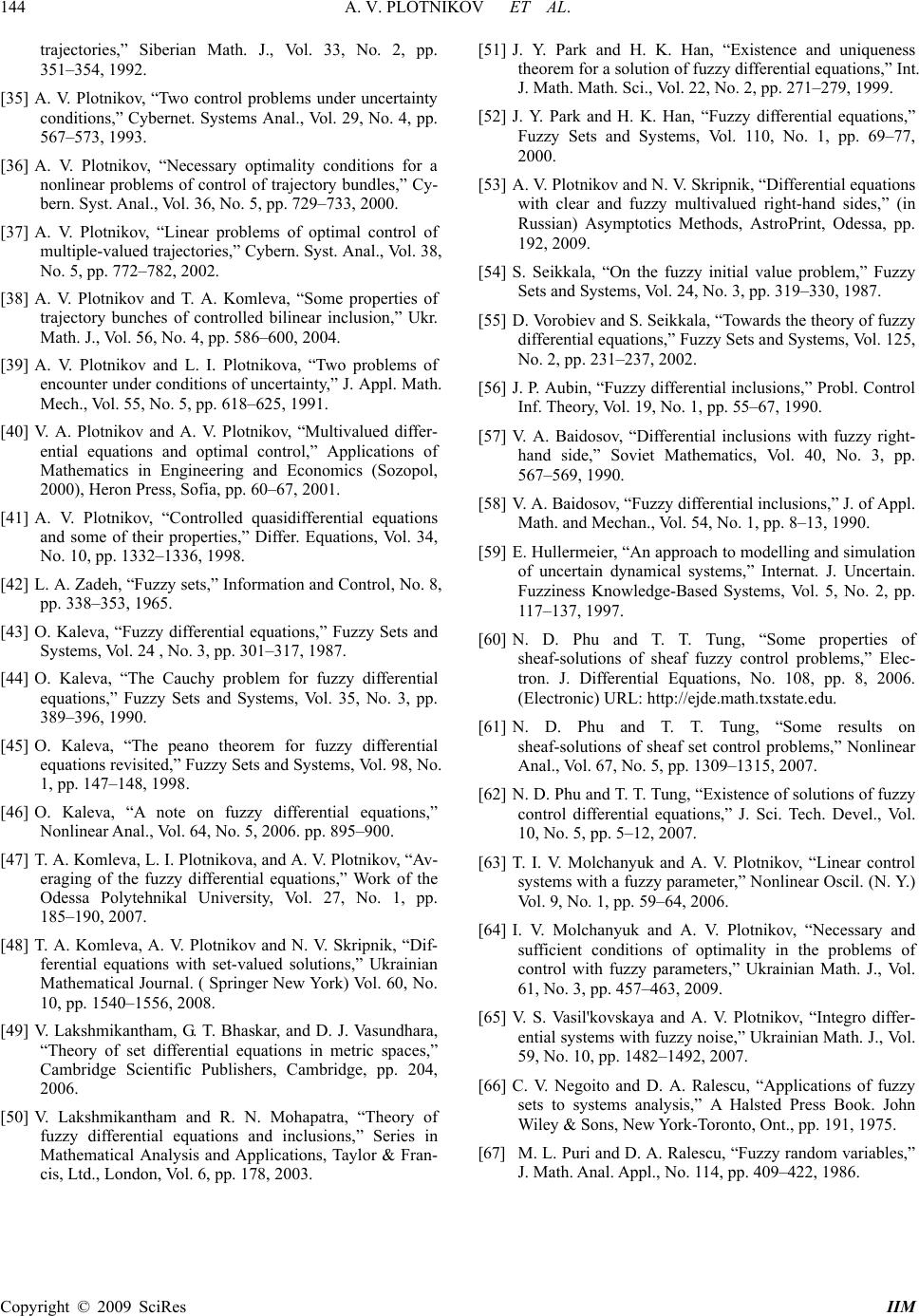 A. V. PLOTNIKOV ET AL. Copyright © 2009 SciRes IIM 144 ons,” Cybernet. Systems Anal., Vol. 29, No. 4, pp. s of control of trajectory bundles,” Cy- ectories,” Cybern. Syst. Anal., Vol. 38 uncertainty,” J. Appl. Math lications of tial equations ol. 98 Vol. 64, No. 5, 2006. pp. 895–900. University, Vol. 27, No. 1, pp. “Dif- m, G. T. Bhaskar, and D. J. Vasundhara, . N. Mohapatra, “Theory of equations,” Int. , lear and fuzzy multivalued right-hand sides,” (in ems, Vol. 24, No. 3, pp. 319–330, 1987. 25, . 55–67, 1990. o. 3, pp. Vol. 54, No. 1, pp. 8–13, 1990. rtain. fuzzy control problems,” Elec- Nonlinear Devel., Vol. eter,” Nonlinear Oscil. (N. Y.) ity in the problems of ,” Ukrainian Math. J., Vol. Press Book. John trajectories,” Siberian Math. J., Vol. 33, No. 2, pp. 351–354, 1992. [35] A. V. Plotnikov, “Two control problems under uncertainty conditi 567–573, 1993. [36] A. V. Plotnikov, “Necessary optimality conditions for a nonlinear problem bern. Syst. Anal., Vol. 36, No. 5, pp. 729–733, 2000. [37] A. V. Plotnikov, “Linear problems of optimal control of multiple-valued traj, Ru No. 5, pp. 772–782, 2002. [38] A. V. Plotnikov and T. A. Komleva, “Some properties of trajectory bunches of controlled bilinear inclusion,” Ukr. [55] D. V orobiev and S. Seikkala, “Towards the theory of fuzzy differential equations,” Fuzzy Sets and Systems, Vol. 1 Math. J., Vol. 56, No. 4, pp. 586–600, 2004. [39] A. V. Plotnikov and L. I. Plotnikova, “Two problems of encounter under conditions of. No Mech., Vol. 55, No. 5, pp. 618–625, 1991. [40] V. A. Plotnikov and A. V. Plotnikov, “Multivalued differ- ential equations and optimal control,” App Mathematics in Engineering and Economics (Sozopol, 2000), Heron Press, Sofia, pp. 60–67, 2001. [41] A. V. Plotnikov, “Controlled quasidifferen 567– and some of their properties,” Differ. Equations, Vol. 34, No. 10, pp. 1332–1336, 1998. [42] L. A. Zadeh, “Fuzzy sets,” Information and Control, No. 8, pp. 338–353, 1965. [43] O. Kaleva, “Fuzzy differential equations,” Fuzzy Sets and Systems, Vol. 24 , No. 3, pp. 301–317, 1987. [44] O. Kaleva, “The Cauchy problem for fuzzy differential equations,” Fuzzy Sets and Systems, Vol. 35, No. 3, pp. 389–396, 1990. [45] O. Kaleva, “The peano theorem for fuzzy differential equations revisited,” Fuzzy Sets and Systems, V, No. Anal., Vol. 67, No. 5, pp. 1309–1315, 2007. [62] N. D. Phu and T. T. Tung, “Existence of solutions of fuzzy control differential equations,” J. Sci. Tech. 1, pp. 147–148, 1998. [46] O. Kaleva, “A note on fuzzy differential equations,” Nonlinear Anal., [47] T. A. Komleva, L. I. Plotnikova, and A. V. Plotnikov, “Av- eraging of the fuzzy differential equations,” Work of the Odessa Polytehnikal 185–190, 2007. [48] T. A. Komleva, A. V. Plotnikov and N. V. Skripnik, ferential equations with set-valued solutions,” Ukrainian Mathematical Journal. ( Springer New York) Vol. 60, No. 10, pp. 1540–1556, 2008. [49] V. Lakshmikantha cont “Theory of set differential equations in metric spaces,” Cambridge Scientific Publishers, Cambridge, pp. 204, 2006. [50] V . Lakshmikantham and R 59, N fuzzy differential equations and inclusions,” Series in Mathematical Analysis and Applications, Taylor & Fran- cis, Ltd., London, Vol. 6, pp. 178, 2003. [51] J. Y. Park and H. K. Han, “Existence and uniqueness theorem for a solution of fuzzy differential J. Math. Math. Sci., Vol. 22, No. 2, pp. 271–279, 1999. [52] J. Y. Park and H. K. Han, “Fuzzy differential equations,” Fuzzy Sets and Systems, Vol. 110, No. 1, pp. 69–77 2000. [53] A. V. Plotnikov and N. V. Skripnik, “Differential equations with c ssian) Asymptotics Methods, AstroPrint, Odessa, pp. 192, 2009. [54] S. Seikkala, “On the fuzzy initial value problem,” Fuzzy Sets and Syst . 2, pp. 231–237, 2002. [56] J. P. Aubin, “Fuzzy differential inclusions,” Probl. Control Inf. Theory, Vol. 19, No. 1, pp [57] V. A. Baidosov, “Differential inclusions with fuzzy right- hand side,” Soviet Mathematics, Vol. 40, N 569, 1990. [58] V. A. Baidosov, “Fuzzy differential inclusions,” J. of Appl. Math. and Mechan., [59] E. Hullermeier, “An approach to modelling and simulation of uncertain dynamical systems,” Internat. J. Unce Fuzziness Knowledge-Based Systems, Vol. 5, No. 2, pp. 117–137, 1997. [60] N. D. Phu and T. T. Tung, “Some properties of sheaf-solutions of sheaf tron. J. Differential Equations, No. 108, pp. 8, 2006. (Electronic) URL: http://ejde.math.txstate.edu. [61] N. D. Phu and T. T. Tung, “Some results on sheaf-solutions of sheaf set control problems,” 10, No. 5, pp. 5–12, 2007. [63] T. I. V. Molchanyuk and A. V. Plotnikov, “Linear control systems with a fuzzy param Vol. 9, No. 1, pp. 59–64, 2006. [64] I. V. Molchanyuk and A. V. Plotnikov, “Necessary and sufficient conditions of optimal rol with fuzzy parameters,” Ukrainian Math. J., Vol. 61, No. 3, pp. 457–463, 2009. [65] V. S. Vasil'kovskaya and A. V. Plotnikov, “Integro differ- ential systems with fuzzy noise o. 10, pp. 1482–1492, 2007. [66] C. V. Negoito and D. A. Ralescu, “Applications of fuzzy sets to systems analysis,” A Halsted Wiley & Sons, New York-Toronto, Ont., pp. 191, 1975. [67] M. L. Puri and D. A. Ralescu, “Fuzzy random variables,” J. Math. Anal. Appl., No. 114, pp. 409–422, 1986. |

